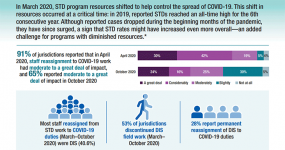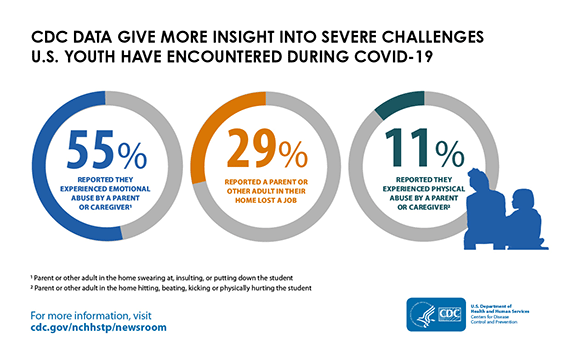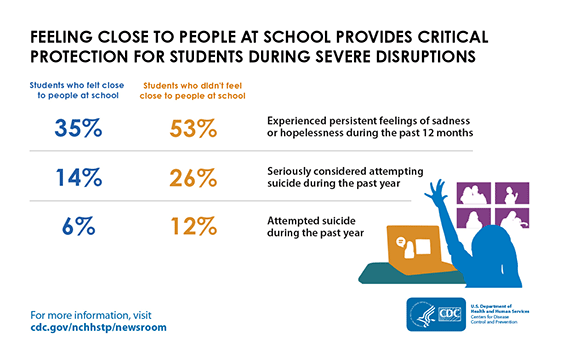Connections (Mar-Apr 2022)
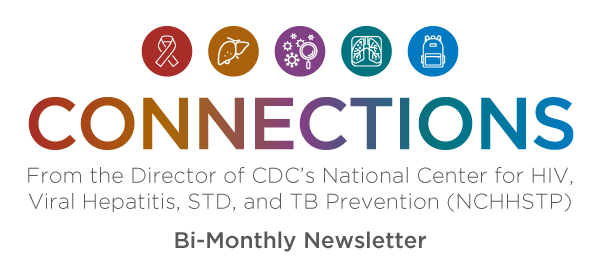
March – April 2022
From the Director - Jonathan Mermin, MD, MPH
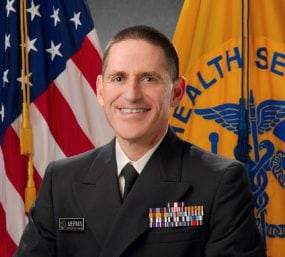
How have our nation’s youth fared during the COVID-19 pandemic? Recent data from CDC’s Adolescent Behaviors and Experiences Survey (ABES) provide new—and actionable—insight into the state of youth mental health in America .
Before the pandemic, mental health was getting worse among high school students, according to prior CDC data. With funding from the Coronavirus Aid, Relief, and Economic Security (CARES) Act, CDC designed ABES so that we could better understand the various threats—both physical and mental—that our children have been facing during COVID-19. U.S. high school students participated in this voluntary, nationally representative survey in 2021.
Our data make it clear that all young people have experienced significant disruption and adversity during the pandemic—but all students have not been affected equally. Many of our findings are deeply troubling.
Some findings show:
- More than 1 in 3 high school students reported they experienced poor mental health during the pandemic, and nearly half of students reported they felt emotional distress.
- Female students and those who identify as lesbian, gay, bisexual, other or questioning (LGBQ) reported they experienced disproportionate levels of poor mental health and suicide-related behaviors. For instance, 12% of female students, more than 25% of LGB students, and 17% of other or questioning students reported they attempted suicide during the past year compared to 5% for both male and heterosexual students.
- LGB students were also far more likely to report physical abuse, with 20% reporting physical abuse by a parent or other adult in their home, compared to 10% of heterosexual students.
- More than one third of students reported they experienced racism at school, either before or during the pandemic—with the highest reports among Asian students, Black students, and students of multiple students who reported experiencing racism were also more likely to report that they also experienced poor mental health than those who had not experienced racism.
What can be done to support youth and improve mental health? Our data also speak powerfully to the importance of schools in mitigating the impact of the pandemic. In the ABES survey, we found that youth who felt more connected to people at their schools had better mental health—and were much less likely to report that they felt sad or hopeless; considered attempting suicide; or attempted suicide than those who did not feel connected. Conversely, students who did not feel connected to people at school had worse mental health.
However, we also saw that youth who experienced racism—and LGB youth—were less likely to feel connected to people at their school. There is much that can be done to make sure that LGBTQ youth and youth from racial and ethnic minority groups feel safe supported and connected in their schools.
Right now, young people need all the support we can give them. CDC’s What Works in Schools program incorporates specific strategies schools can use to help all students feel safer and more supported.
The findings raise some very complex issues, and schools cannot address them alone. These data are critical for informing solutions needed to address the factors that threaten the well-being of our youth. The impact of COVID-19 will be felt for many years. Together, we can work toward a better future for our adolescents’ health and well-being.
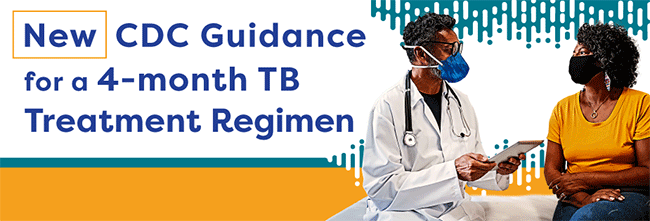
On February 25, 2022, CDC released new interim guidance in Morbidity and Mortality Weekly Report regarding a 4-month treatment regimen to treat drug-susceptible TB disease in the United States. The 4-month regimen, which is as effective as the standard 6-month regimen for TB treatment, is a daily treatment option for people 12 years of age and older with drug-susceptible pulmonary TB disease. The 4-month treatment regimen consists of high-dose daily rifapentine with moxifloxacin, isoniazid, and pyrazinamide.
Summary Sources
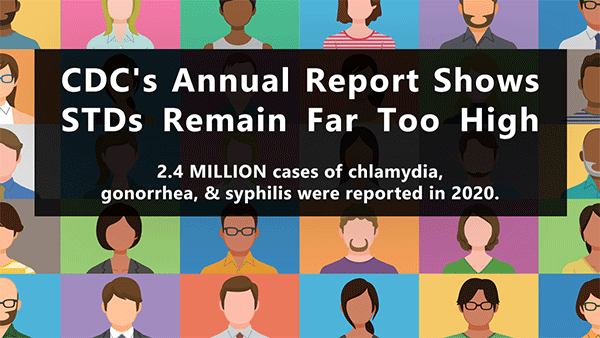
2020 STD Surveillance Report
During STD Awareness Week, CDC released the Sexually Transmitted Disease (STD) Surveillance, 2020. The annual report shows that reported cases of gonorrhea, syphilis, and congenital syphilis dropped dramatically and later resurged in the first year of the coronavirus disease 2019 (COVID-19) pandemic.
Leonardo Mena, MD, MPH, Director of STD Prevention, NCHHSTP, CDC, offers a glimmer of hope in an otherwise concerning report.
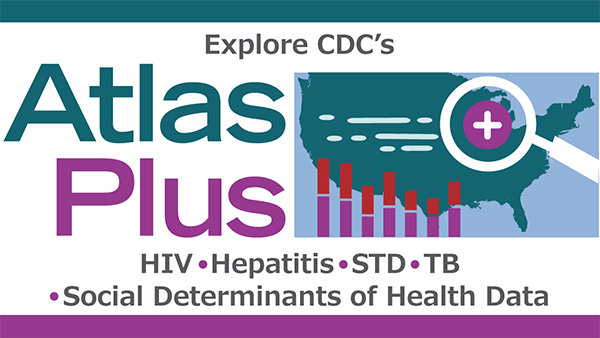
CDC’s AtlasPlus
CDC’s AtlasPlus gives you quick access to nearly 20 years of CDC’s surveillance data on HIV, viral hepatitis, sexually transmitted diseases (STDs), and tuberculosis (TB) at the national, state and county levels. Users can also view social and economic data in conjunction with HIV, viral hepatitis, STDs, and TB infections. New updates are now available including 2020 data on TB diagnoses, along with updated preliminary 2020 and 2021 data on HIV diagnoses, linkage to care, and PrEP coverage. Gender data are also now available at the national level for select HIV indicators.
CDC Recommendations for Correctional and Detention Settings
We have a new quick reference document entitled, CDC recommendations for correctional and detention settings. This new resource summarizes testing, vaccination, and treatment recommendations for HIV, viral hepatitis, sexually transmitted infections (STIs), and TB and highlights critical public health actions applicable at intake, during incarceration/ detention, and at release. Read more about our correctional health care recommendations in my recent Dear Colleague Letter.
Fiscal Year (2021) Extramural Resources
Our new CDC NCHHSTP website shows the five-year enacted funding history for HIV, viral hepatitis, STIs, TB, and Infectious Disease and the Opioid Epidemic (IDO). The Fiscal Year (FY) 2021 Extramural Resources website and associated interactive map shows how much funding in FY 2021 CDC invested in each state and territory, freely associated state, and Washington D.C. categorized by the following CDC budget accounts: HIV, viral hepatitis, STIs, TB, and IDO prevention.
From CDC’s National Prevention Information Network (NPIN)
For those new to the NPIN community, it is a source of information and materials for HIV, viral hepatitis, TB, and STDs education and prevention resources. In this month’s newsletter, learn how NPIN provided comprehensive promotional support to all of NCHHSTP’s divisions.
HBV Vaccine Recommendations
On March 31, 2022, CDC published, the updated hepatitis B vaccination recommendations that all adults aged 19 through 59 years receive the hepatitis B vaccine. Adults aged 60 years and older with known risk factors for hepatitis B may also receive the hepatitis B vaccine. My latest Dear Colleague Letter discusses the existing and new recommendations of this vaccine to help us move forward on reducing the burden of hepatitis B and ultimately eliminating the virus in the United States.
How COVID-19 Impacted STD Programs
CDC released an infographic pdf on how STD program resources shifted to help control the spread of COVID-19. The infographic is based on a paper authored by several DSTDP staff entitled, Impact of the COVID-19 Pandemic on Centers for Disease Control and Prevention-Funded STD Programs
National Women and Girls HIV/AIDS Awareness Day (NWGHAAD)
NWGHAAD was March 10. CDC shared a digital toolkit with our partners to strengthen our commitment to improve women’s access to HIV testing, treatment, and prevention during this significant observance. Learn more in my Dear Colleague Letter.
National Youth HIV/AIDS Awareness Day (NYHAAD)
For National Youth HIV & AIDS Awareness Day (NYHAAD) on April 10, CDC produced and distributed a social media toolkit to share resources about this important observance. Kathleen Ethier, PhD, Director, Division of School and Adolescent Heath, NCHHSTP, CDC also helped bring awareness to this annual health observance to educate the public about the national impact of HIV on youth.
New Blog Posts at HIV.gov
CDC cautioned that there is a large, ongoing outbreak of meningococcal disease in Florida, primarily among gay, bisexual, and other men who have sex with men, including those living with HIV. Learn more on how to protect yourself from this serious disease.
CDC Director, Dr. Walensky, released a commentary on HIV and women for National Women’s Health Month.
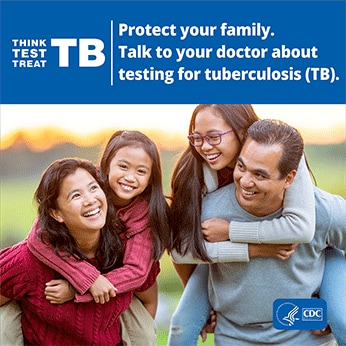
NEW Think. Test. Treat TB Campaign
CDC launched a new communications campaign, Think. Test. Treat TB, to raise awareness of latent TB infection. The campaign aims to reach people most at risk for latent TB infection and their healthcare providers to accelerate progress towards TB elimination. This is the first national multilingual communications campaign to address latent TB infection, including a partner toolkit. The campaign is also featured in the recent CDC Did You Know (DYK).
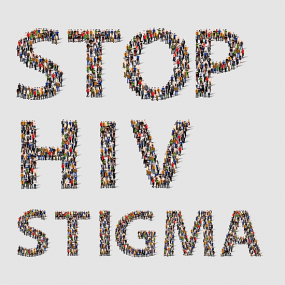
NEW Stop HIV Stigma Toolkit
The Let’s Stop HIV Together (Together) campaign released a new social media Stop HIV Stigma toolkit. The social media toolkit contains ready-to-go messages for posting on Facebook, Instagram, or Twitter. The messages encourage everyone to lead with love, not hate, get the facts about HIV, and educate others.
Strengthening Syringe Services Programs
The deadline to apply for the Strengthening of Syringe Services Programs Notice of Funding Opportunity (NOFO) is May 2, 2022. In a recent article, Carolyn Wester, MD, Director, Division of Viral Hepatitis, NCHHSTP, CDC discussed the need to increase access to harm reduction services for people who inject or have a history of injecting drugs.
The Role of HIV Self-Testing in Ending the HIV Epidemic
Ensuring that everyone gets tested for HIV is a critical first step to end the epidemic and is a core strategy of the federal Ending the HIV Epidemic in the United States initiative. HIV testing serves as a pathway to prevention and care services for all people. Any HIV test result should lead to engagement in high-quality health care for people who could benefit from HIV prevention or treatment. For people with undiagnosed HIV, testing enables them to begin HIV treatment to protect their health, prevent further transmission of the virus, and access testing and treatment for other sexually transmitted infections (STIs).
Additional findings from ABES found that 55% that youth reported experiencing emotional abuse by a parent or caregiver, 29% reported a parent or other adult in their home lost a job , and 11% reported experiencing physical abuse by a parent or caregiver.
Our survey also found students who felt close to people at school were protected during times of severe disruption.
Recent Media Coverage
- Pandemic took a toll on teen mental health, US study says – Associated Press
- ‘A cry for help’: CDC warns of a steep decline in teen mental health – The Washington Post
- ‘Youth are in crisis’: Mental health of US high school students worsened during the Covid-19 pandemic, CDC survey finds – CNN
- Teenagers Report Growing Anxiety. Maybe That’s Rational. – The New York Times, Op-Ed
- Depression, suicidal thoughts prevalent in high school students during pandemic -U.S. study – Reuters
- More Than a Third of Students Had Poor Mental Health During the Pandemic – U.S. News & World Report
- New data on teens’ mental health during pandemic ‘echo a cry for help,’ CDC official says – ABC News, Good Morning America
- CDC reports on teens’ mental health during pandemic reveal alarming trends – American Academy of Pediatrics
To get the latest news and announcements from our Center, check out the NCHHSTP newsroom.
Dr. Jonathan Mermin
@DrMerminCDC
- March 10: National Women and Girls HIV/AIDS Awareness Day
- March 20: National Native HIV/AIDS Awareness Day
- March 24: World TB Day
- April 10: National Youth HIV/AIDS Awareness Day
- April 18: National Transgender HIV Testing Day

Mary Cashin
Do you have feedback, story ideas, content you would like to see in the newsletter? Contact us
Get Connections. Your more interesting inbox awaits!
Subscribe now
Mary Cashin
Do you have feedback, story ideas, content you would like to see in the newsletter? Contact us
Get Connections in your inbox
